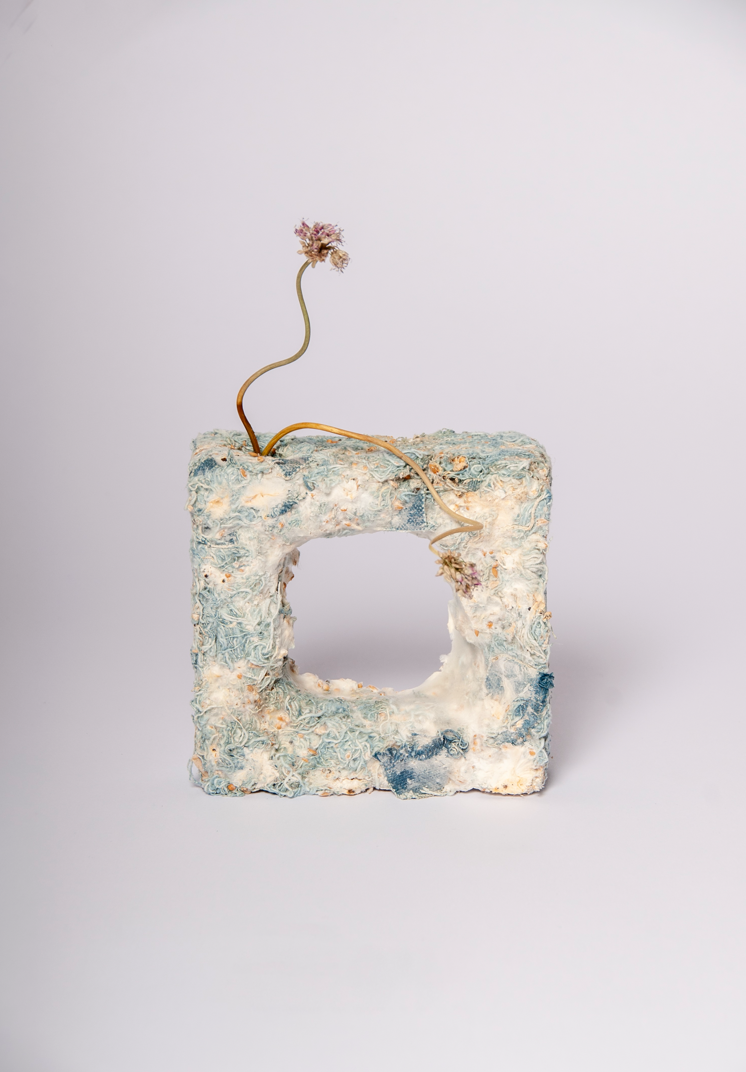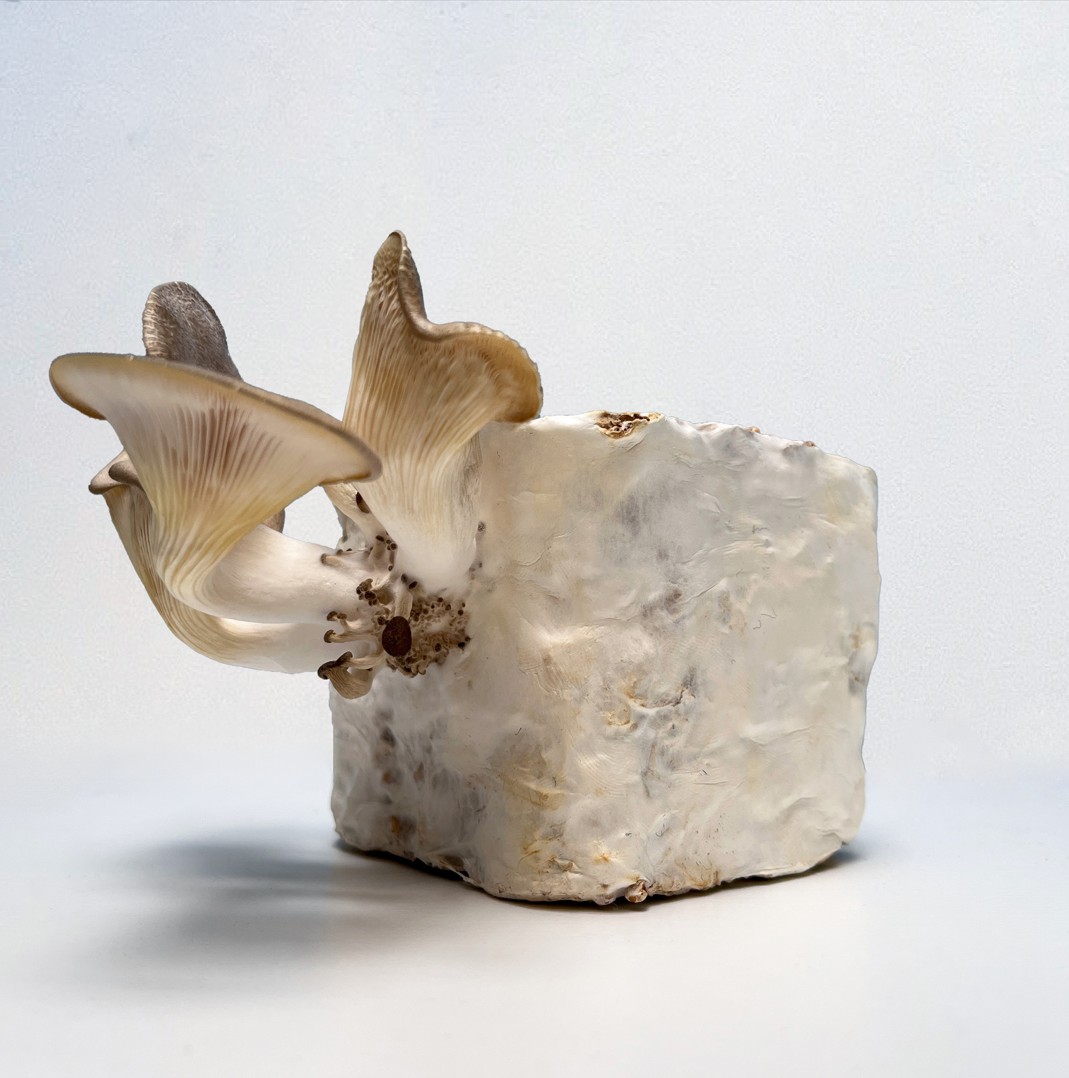Bringing Life to Waste: the organic design of Bella Stern
There’s a quiet reverence in the work of Bella Stern - one that beckons us to slow down, reconsider our material world, and witness nature as both sculptor and collaborator. An American bio-designer, researcher, and set designer now based in Paris, Stern merges her scientific background with artistic intuition. With a Master’s in Fashion Studies from Parsons Paris and a dual undergraduate degree in Psychology and French from Villanova University and a Sustainability minor, her interdisciplinary approach feels both studied and instinctual.
At the heart of Stern’s practice is mycelium, the root-like system of fungi. Far from the sterile environment of laboratories, she brings this living material into intimate, everyday settings, prompting reflection on growth, decay, and the value of impermanence. Her low-tech processes embrace unpredictability, turning waste materials like coffee grounds, shell fragments, and textile scraps into elegant forms that biodegrade gracefully. Her recent solo show in Paris marked a pivotal moment, presenting a series of works that challenge how we relate to our garments, our homes, and the earth beneath them.
We caught up with Bella to understand more about her process, philosophies, and the living, breathing materials she calls her creative partners.
How would you describe the art that you create?
The art I create is often supposed to be functional and live with you. They are meant to live in your home alongside you and be composted at the end of their life. They are time capsules that act as constant reminders of temporality and life.
Each piece is a mixture of mycelium with a waste substrate (often paper, textile waste, shell food waste, and coffee grounds). I create a custom mold for the object, and fill it with the mixture. I let it sit for five to seven days, unmold it, and then let it air dry so that the mycelium enters a state of dormancy. It often fruits mushrooms when drying, but once dry it won't grow anymore and lasts in this state until it's submerged in water for over 24 hours or placed back in the soil. While air drying takes longer than putting it in an oven, I do it out of respect for my non-human collaborator as this does not kill it. This also ensures that once the piece or experiment is over, I can put it back in the soil for it to continue its work and life.
What are the main messages that the art you create communicates?
For me, I want my pieces to question traditional and common models of what we think of when we think of sustainability. Often sustainable products are products that need to last forever. This is true in a way - we want our clothes and furniture to be well made - something that has gone downhill in the last 30 years - but I find that the materials used often can't be recycled or composted due to their construction. My work is meant to contradict this, to remind us that 1) we should be creating with end of life in mind and 2) the objects we do create often return to the earth as poison, not as food. I want what I create to enrich the soil and the next generation of flora and fauna, not destroy it.
How would you describe the emotions that your art aims the observer to feel?
I hope that the pieces evoke awe, warmth, and a deeper sense of connection to nature and the environment. Mycelium is not a common medium so there are always loads of questions when people discover it for the first time, but once they understand, there is this connection to a piece, to the mycelium that I don't typically find with other mediums. It’s almost as if they have a new appreciation for each piece because they recognize that it's alive.
In terms of creative collaboration, how do you see the idea of bringing someone else’s vision together with your artistic talent – what outcome could that create?
I absolutely love collaboration and I wish I had more chances to do it! I already view mycelium as a collaborator in this process as it imparts its wishes and is the physical and metaphorical glue that holds the work together, but it’s one that cannot talk, so I love to work with others. I am open to other ideas and inputs as long as they realize that working with mycelium is not like working with other “materials.” In working with mycelium you have to accept letting go and not having control over the final outcome in each piece. I make each mold and choose the substrate but the mycelium decides how it wants to grow and if it wants to grow at all.
Which part of your creative process do you enjoy the most?
The unmolding process is definitely my favorite. Often the molds I make are opaque so I can't see if the mycelium is growing or if it's been contaminated so the unmolding is very much a “moment of truth” during the creation process. It's also when I see if what I had in my head is what is physically present. Sometimes I do some basic sketches of the piece and then tweaks when making the molds but I don't do any renderings so I often don't have any idea of what it will look like beforehand.
Do you have any creative rituals that you always follow when creating? If yes, what are they and what do they give to your creative process?
After the molds have been made and everything is clean, I set everything I need up to work and then take a deep breath and close my eyes. I center myself and try to be as present as possible when inoculating the molds. When working with a living organism I want to acknowledge that this is a collaboration and one that I don't take for granted.
Through her evolving practice, Bella Stern invites us to imagine a future where waste is sacred, decay is beautiful, and design lives - and dies - with intention. In her hands, mycelium isn’t just a material; it’s a philosophy.






